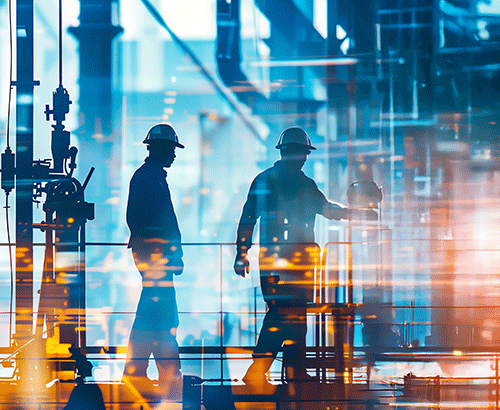Artificial Intelligence for Engineering and Construction Firms

In numerous industries, technical jargon can pose a challenge for those unfamiliar with it.
Construction is no exception, employing terms such as earned value, design-bid-build and WIP (work-in-progress), which are typically only familiar to construction industry professionals.
While the tech sector may be the most prolific source of industry-specific terminology, contractors are gradually evolving into tech companies in their own rights. Software, technology and associated salaries can generally be the second-highest cost on an average contractor’s income statement, according to an FMI analysis of clients’ financial statements.
By increasingly adopting software and technology to incorporate data-driven decision making, they introduce technical terms like virtual design and construction (VDC), building information modeling (BIM), cloud computing and application programming interface (API).
One term that has transitioned from industry-specific jargon to everyday conversation, primarily due to the disruptive impact of OpenAI’s ChatGPT, is artificial intelligence (AI). Distinguishing between the hype and reality of AI’s capabilities can be difficult, given its prominence in today’s conversations. It’s time to cut through the noise and discuss how AI is truly changing the construction industry – without invoking images of autonomous humanoid robots capable of climbing a ladder to terminate wire or anything else.
There’s an ever-growing communication gap between AI’s most vocal advocates and average business owners or executives. Some may be overly optimistic, believing that AI can solve all the construction industry’s problems, while others might avoid the technology altogether due to fears of job displacement or a lack of understanding its applications.
What is often missing from the conversation about AI is a practical understanding of its capabilities, along with a perspective that is neither too optimistic nor too pessimistic, but rather realistic. Developing a realistic view is essential for many contractors as they determine their defensive and offensive strategies. How do we protect ourselves from the implications associated with our work’s exposure to AI, or what many researchers are studying as a means to explore possible job displacement, and how do we leverage the technology to remain competitive?
Demystifying AI
Artificial intelligence refers to computer systems that can simulate certain aspects of human intelligence to execute tasks such as problem-solving, decision making and learning. However, it’s important to note that current AI models are limited in their abilities and can only perform specific tasks they have been trained to do. In other words, they lack the flexibility and adaptability of human intelligence. Put simply, AI is designed to perform one task at a time and cannot easily switch between tasks or perform new ones.
Many researchers and academics broadly separate AI into three categories – Artificial Superintelligence (ASI), Artificial General Intelligence (AGI) and Artificial Narrow Intelligence (ANI). ASI is where machines become self-aware and surpass human intellect. This form of AI is merely hypothetical. AGI, or strong AI, is the concept of a machine with general intelligence that simulates human intelligence and behaviors, with the ability to learn and solve any problem the way we do. This too remains in the realm of science fiction, with a leading MIT roboticist predicting that AGI won’t arrive until the year 2300.
Artificial Narrow Intelligence (ANI), or weak AI, is designed to complete a single task without human assistance. It is trained to do one thing and automatically apply the knowledge gained from performing that task to the next. Its function is narrow in scope. Some currently utilized ANI models are in smart speakers, self-driving cars, web searches, AI farming and manufacturing. ANI is widely used in industry today and has the potential to reshape construction operations in the future.
Example: Futuristic Farming
One success story in AI involves an agriculture start-up company called Blue River Technology, a grassroots effort started by two graduate students. The founders began by manually taking pictures in the field with handheld cameras to train their AI model, then started selling their product to one farmer at a time. Blue River developed and fielded real-time autonomous agriculture robots that see and spray.
These tractor attachments use computer vision that combines cameras and algorithms to distinguish between weeds and crops, and sprays herbicides on only the weeds. This AI-enhanced technology reduced chemical usage by more than 90%, resulting in tremendous cost savings. John Deere ultimately acquired Blue River for $305 million in 2017.
The Business Value of AI
The global AI market is projected to increase by a compound annual growth rate (CAGR) of 39.4%, reaching roughly $422 billion by 2028. Many industries, including construction, recognize opportunities to increase efficiency and profitability by leveraging this tool. A six-year data series conducted by IBM revealed that early adopters of AI reported operating cost savings related to process efficiency, supply chain and production optimization, and labor efficiency. Companies involved in this study reported 6.3 percentage points of direct revenue gains directly attributable to AI on average.
Engineering and construction (E&C) leaders predict that AI will have an immense impact on the industry. James Barret, chief innovation officer for Turner Construction, told Construction Dive that “Artificial intelligence will transform the industry in the next 10 years more than any other technology has in the past century.” In other words, the widespread adoption of AI-enhanced operational processes may transform from a competitive advantage to a necessity for staying competitive.
Enhancing Labor, Not Replacing It
There are countless examples of how AI-enhanced processes can improve construction operations, but most interestingly is how it can address construction labor shortages. It may seem counterintuitive to suggest leveraging a technology that many fear will replace construction jobs to address labor shortages.
It’s natural to be concerned about job displacement due to AI, especially when you consider how robotics and automation systems have already displaced millions of jobs, 1.7 million in manufacturing since 2000.
However, it’s important to remember how ANI is generally only capable of carrying out specific and controlled functions. Unlike manufacturing, construction projects usually involve building something that has never been built in the exact same way, and in a dynamic and constantly changing environment.
Along with installing materials by utilizing skills developed from years of experience, skilled trade workers execute tasks that involve intuition, splitsecond decision making, creativity, flexible task reorientation and interactive communication. We have potentially hundreds of years before machines are equipped with an AGI capable of simulating the human intelligence and behaviors necessary to replace skilled construction labor.
Addressing Labor Challenges by Complementing Human Skills
Construction labor challenges have plagued the industry for more than 100 years. These challenges remain pervasive today and appear to be getting worse. There’s a widening gap between workers exiting and entering the workforce – there are fewer young professionals entering the market to replace a retiring generation.
Meanwhile, construction productivity is decreasing – the number of workers required per dollar of construction put in place is increasing as the value of work decreases. These labor-related challenges contribute to contractors feeling like they’re doing less work for higher costs. With few options to acquire talented and experienced field leaders, contractors need to start promoting from within their organizations, prioritizing the training and development of younger generations, while seeking to optimize internal processes that ultimately result in greater productivity, lower costs and higher profit margins.
While AI will not be able to address all the workforce challenges facing the industry, contractors are at a critical juncture. With a shortage of clear solutions, they must either think creatively and be open to innovative ideas or risk falling behind early-adopting competitors.
New Tools Available
In recent years, AI has become significantly more democratized and commercially available to consumers and industry professionals. For instance, ChatGPT disrupted numerous industries by providing immediate and highly personalized responses to user questions and tasks, improving efficiency and productivity. This technology has become user-friendly, allowing construction crews to benefit from AI. There are currently several tools that do not demand any more technical knowledge than Microsoft Excel. These user-friendly tools are currently being leveraged to support training and development, optimize internal processes and increase job site productivity.
AI-Enabled Scheduling: ALICE, short for Artificial Intelligence Construction Engineering, is an AI construction scheduling platform that optimizes project schedules by applying AI algorithms to project resources and constraints. The program generates dozens of schedule sequence options in minutes and allows users to quantify the cost and time impact of different decisions by running analyses of different scenarios. For example, ALICE can tell the schedule and budget impacts of adding an additional crew or piece of equipment. Users of ALICE have reported tangible reductions in project direction as well as labor and cost savings.
Estimating with Deep Machine Learning: Togal.AI is an AI-enhanced preconstruction technology that claims to be the first and only estimating software that utilizes machine learning algorithms fine-tuned for automatically detecting, measuring, comparing and labeling project spaces and features on design drawings. The Associated General Contractors of America (AGC) named Miami-based Coastal Contractors a 2023 AGC Construction Innovation Award finalist for using Togal.AI to complete construction bids faster and more efficiently. Coastal Construction’s chairman and CEO stated that using Togal.AI cut nearly 14,000 hours of work, saving close to $1 million in the company’s first year using it.
Safety Monitoring with Computer Vision and Predictive Analytics: Newmetrix is an AI platform, recently acquired by software developer Oracle, that uses computer vision or visual recognition and predictive analytics to analyze photos and videos taken from construction sites. It identifies safety hazards and provides feedback to the user regarding best practices. Suffolk reported that after 12 months of implementing the program, it reduced recordable incidents by 28% and cut lost time by 35%. By incorporating this tool into training programs, construction professionals can learn safety best practices from real-world examples.
Machine Learning-Enhanced Submittal and Closeout Process Automation: Pype aims to increase productivity and reduce risk by automating submittal and closeout workflows. Pype Autospecs uses machine learning algorithms to read and extract specs to generate submittal logs, and Pype Closeout enhances closeout through user-friendly, centralized dashboards with automated document collection features. In 2020 Pype was acquired by Autodesk, one of the construction industries most ubiquitous software developers, and has since been integrated into Autodesk’s Construction Cloud platform. Jacobsen Construction reported time savings of 90% on spec reviews.
Quality Control and Productivity Enhancement with Computer Vision and Predictive Analytics: Doxel AI uses data gathered from autonomous drones and rovers outfitted with high-definition cameras and lidar. AI algorithms analyze this data against the building information modeling (BIM) models, schedules and estimates. The program automatically inspects installed work and provides information on the percentage of the project completed, which informs billings decisions, scheduling, sequencing and other project management decisions. Last year, Doxel reportedly increased labor productivity by 38% during a project with Kaiser Permanente, contributing to an 11% budget underrun. The resulting insights from completed projects can be incorporated into training programs, allowing for developing construction professionals to learn about appropriate resource allocation and productivity by project size, type, location and other factors.
AI-Enhanced Personal Productivity Tools: There are several reputable and widely adopted AI-enabled personal productivity tools that support writing content, meeting assistance, note-taking, audio-to-text transcription, presentation slide deck generation and research. Many of these tools are free or have a tiered payment structure.
- TIME TRACKING: Time Doctor tracks work time, monitors activity and integrates commonly used software applications like Microsoft Outlook and project management platforms and provides a detailed report on time spent on each customer, task and project.
- PERSONAL SCHEDULING ASSISTANT: Reclaim.ai integrates with your calendar and optimizes your schedule around your task priorities, auto-blocks time for routines, finds the optimal meeting times, and adds breaks and travel time around meetings.
- NOTE-TAKING: Mem is an app that automatically sends you and your contacts calendar invites and reminders based off the notes you take.
Construction operations could be on the cusp of a transformational shift with the adoption of artificial intelligence to optimize processes, boost efficiency and supplement the labor force. While AI won’t supplant the irreplaceable skills of experienced construction professionals, it can augment their abilities, elevating operational efficiency. However, it is critical for contractors to understand that to be prepared to leverage the potential benefits of AI, they must first have the data infrastructure in place to support it.
As the industry evolves, a pragmatic understanding of AI’s capabilities and constraints, coupled with an openness to embrace innovation and think inventively, will be crucial for contractors to remain competitive and address some of the challenges facing the industry. By integrating AI into their operations, construction professionals can begin to close the gap between conventional best practices and the technological innovations shaping the future of construction.

.png)

